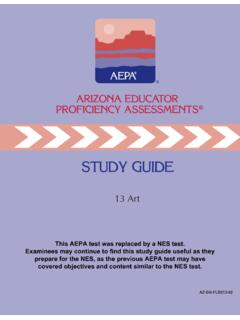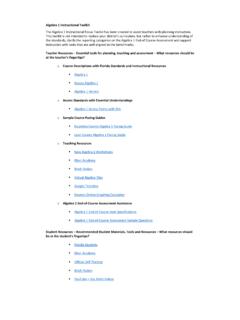Transcription of 10 Mathematics - aepa.nesinc.com
1 AZ-SG-FLD010-0310 MathematicsThis AEPA test was replaced by a NES test. Examinees may continue to find this study guide useful as they prepare for the NES, as the previous AEPA test may have covered objectives and content similar to the NES should be advised that this study guide, including many of theexcerpts used herein, is protected by federal copyright 2009 pearson Education, Inc. or its affiliate(s). All rights Systems, pearson , Box 226, Amherst, MA 01004 AEPA, Arizona Educator Proficiency Assessments, and the AEPA logo are trademarks, in the and/or other countries, of theArizona Department of Education and pearson Education, Inc.
2 Or its affiliate(s). pearson and its logo are trademarks in the and/or other countries of pearson Education, Inc. or its affiliate(s). TABLE OF CONTENTSF ield 10: MathematicsPART 1: GENERAL INFORMATION ABOUT THE AEPA AND TEST PREPARATIONAN OVERVIEW OF THE 1-1 Test Development ProcessCharacteristics of the AEPATest AdministrationHow AEPA Test Scores Are Computed and ReportedHOW TO PREPARE FOR THE 1-3 Study the Test ObjectivesFocus Your StudiesIdentify ResourcesDevelop Study TechniquesAnswer the Practice QuestionsReview the Sample Answer Sheet and Written Response BookletTest DirectionsSample Answer SheetSample Written Response BookletWHAT TO EXPECT THE DAY OF THE 1-12 The Morning of the AdministrationAt the Test SiteSAMPLE
3 TEST OBJECTIVES AND 1-13 Organization of the Test ObjectivesQuestion Formats and StrategiesSelected-Response-Question FormatsPerformance Assignment FormatsEvaluation of the Sample Written Performance Assignment ResponsePART 2: FIELD-SPECIFIC 2-1 TEST 2-2 PRACTICE 2-9 ANSWER 2-65 PREPARATION 2-69 STUDY GUIDE ORDER FORM PART 1:GENERAL INFORMATION ABOUTTHE AEPA AND TEST PREPARATIONPart 1 of this study guide is contained in a separate PDF file. Click the link below to view orprint this section:General Information About the AEPA and Test PreparationArizona Educator Proficiency Assessments Study Guide2-1 PART 2:FIELD-SPECIFIC INFORMATIONF ield 10: MathematicsINTRODUCTIONThis section includes a list of the test objectives, practice questions, an answer key for the selected-responsequestions, and a list of preparation objectives.
4 As noted earlier, the test objectives are broad, conceptual statements that reflect theknowledge, skills, and understanding an entry-level educator needs to practice effectively in Arizona list of test objectives for each test field is the only source of information about what a specific test willcover and therefore should be studied questions. The practice questions for the selected-response and performance assignment sectionsincluded in this section are designed to give you an introduction to the nature of the questions included in theAEPA tests.
5 The practice questions represent the various types of questions you may expect to see on an actualtest; however, they are not designed to provide diagnostic information to help you identify specific areas ofindividual strength or weakness or to predict your performance on the test as a you answer the practice questions, you may wish to use the sample answer sheet and sample WrittenResponse Booklet provided in Part 1 to acquaint yourself with these materials. Use the answer key locatedafter the practice questions to check your answers.
6 Sample responses are provided immediately followingeach written performance assignment. The sample responses in this guide are for illustrative purposes written response should be your original work, written in your own words, and not copied orparaphrased from some other help you identify how the test objectives are measured, the objective statement to which the questioncorresponds is listed in the answer key. When you are finished with the practice questions, you may wish togo back and review the entire list of test objectives and descriptive statements for your test resources.
7 The list of preparation resources has been compiled to assist you in finding relevantmaterials as you prepare to take the Mathematics test. This list is to be considered not as complete, but asrepresentative of the kinds of resources currently available. There may be other materials that may be helpfulto you in preparing to take the may also wish to consult a representative from an Arizona educator preparation program in your arearegarding other potential resources specific to this field. Keep in mind that the use of these materials does notguarantee successful performance on the Educator Proficiency Assessments Study GuideTEST OBJECTIVESF ield 10: MathematicsSUBAREAS:1.
8 Number Sense2. Data Analysis and Probability3. Patterns, algebra , and Functions4. Geometry and Measurement5. Trigonometry and the Conceptual Foundations of Calculus6. Mathematical Structure and LogicNUMBER SENSE0001 Understand principles and concepts related to integers, fractions, decimals, percents, ratios, andproportions and their application to problem example: using a variety of models and methods ( , manipulatives, estimation, technology) toexplore concepts ( , absolute value) and patterns and solve problems involving integers, fractions,decimals, percents, ratios, and the properties of the real and complex number systems, and solve problems related to example.
9 Analyzing and applying properties ( , distributive, associative) of the real andcomplex numbers and their subsystems ( , rational numbers, irrational numbers); applyingprocedures related to order of operations; finding sums, products, powers, and roots of complexnumbers; representing complex numbers as vectors; and recognizing the trigonometric form of acomplex the principles of number example: analyzing properties of divisibility and prime numbers; applying the Euclideanalgorithm; and analyzing properties of congruence classes and modular the principles and properties of discrete Mathematics and the application of discretemathematics to problem example: analyzing and applying the properties of finite sets; solving enumeration and finiteprobability problems; patterns; algorithms and algorithmic thinking; combinatorics; recursiverelationships; sequences and series.
10 And modeling and solving problems using the techniques ofgraph Educator Proficiency Assessments Study Guide2-3 DATA ANALYSIS AND PROBABILITY0005 Understand principles and concepts of descriptive statistics and their application to the example: constructing and interpreting tables, charts, and graphs ( , line plots, stem-and-leafplots, box plots, scatter plots) related to descriptive statistics; determining and interpreting measuresof central tendency and dispersion; interpreting, calculating, and solving problems related tocorrelations, frequency distributions, and percentile scores; and recognizing the effects of datatransformations on measures of central tendency and the fundamental principles of probability and probability example: applying fundamental axioms of probability; computing theoretical probability; usingsimulations to explore real-world situations; applying knowledge of connections between geometryand probability ( , probability as a ratio of two areas).














